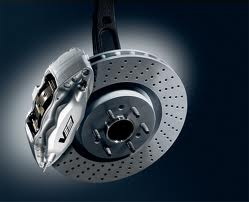|

Brakes
Do you hear your car squeal with pain when you apply your brakes? A squealing or
grinding noise should be investigated immediately. Brake performance has improved in
recent years, but a large percentage of vehicles brakes are not checked regularly. Brake
work performed before you hear those squeals of pain can save you many dollars in
repairs. Worn brake pads that begin to connect metal to metal can ruin your rotors
or drums and add those extra dollars in brake system overhaul. Brakes can be inspected
easily during regular oil change service. An oil change at a full service shop can save
money in the long run. Brake work performed in time saves money as well as lives. Don't
gamble on a few extra miles.
Brake Failure Symptoms
Grinding
A metallic grinding sound indicates your brake pads are worn through. Driving with metal
to metal contact is dangerous and may necessitate replacement of rotors or drums.
Low or Fading Brake Pedal
Do you pump your brakes to stop. Does the pedal sink to the floor when you're stopped at a
light, You could have a leak, air in the brake lines or the brake master cylinder is
leaking internally. Any of these symptoms can be dangerous.
Pulling to One Side or Brake Drag
Most often caused by stuck caliper 'slides' or caliper pistons. The stuck caliper will not
do the same amount of work (stopping) as the other. Immediate repair may save the rotors
from damage.
Anatomy of Brake system
1. Master Cylinder
The master cylinder is the heart of the brake system. Contains the reservoir for the brake fluid. Usually located on the the firewall and should be
checked periodically to ensure the proper fluid level.
2. Brake Lines
Attached to the master cylinder, steel brake tubing runs to all four wheels. Check for
rust, corrosion or other damage which can lead to leaks, Repair should not be delayed.
3. Brake Hoses
Rubber brake hoses run from the brake lines to the brake caliper and wheel cylinders.
Constant exposure to road grime, dirt, salt and the elements can cause the rubber to
become brittle and crack; leading to brake failure. Inspection during each oil change
takes only a few seconds.
4. Linings and Pads
The pads and brake shoe linings should be checked periodically for uneven or excess wear,
glazing, or saturation from brake fluid or grease. How you drive can have a great
effect on how long a set of linings will last. Quick stops, and riding the brakes will
lower the life of any lining.
5. Calipers and Wheel Cylinders
Brakes are activated by brake fluid pressure from the master cylinder pushing a piston
located in the caliper or wheel cylinder against the pad or shoe.
6. Bearings and Seals
Wheel bearings should be inspected and lubricated periodically. A good time to do front
wheel bearing service on rear wheel drive cars is when brake service is performed. The
front wheel bearings on front wheel drive cars are sealed; these bearings
normally need no extra service. The rear wheel bearings on front wheel drive cars can be
checked while doing the regular 30,000 - 60,000 - 90,000 & etc mile
service. Repacked if needed.
7. Parking Brake
Check and adjust periodically.
|

